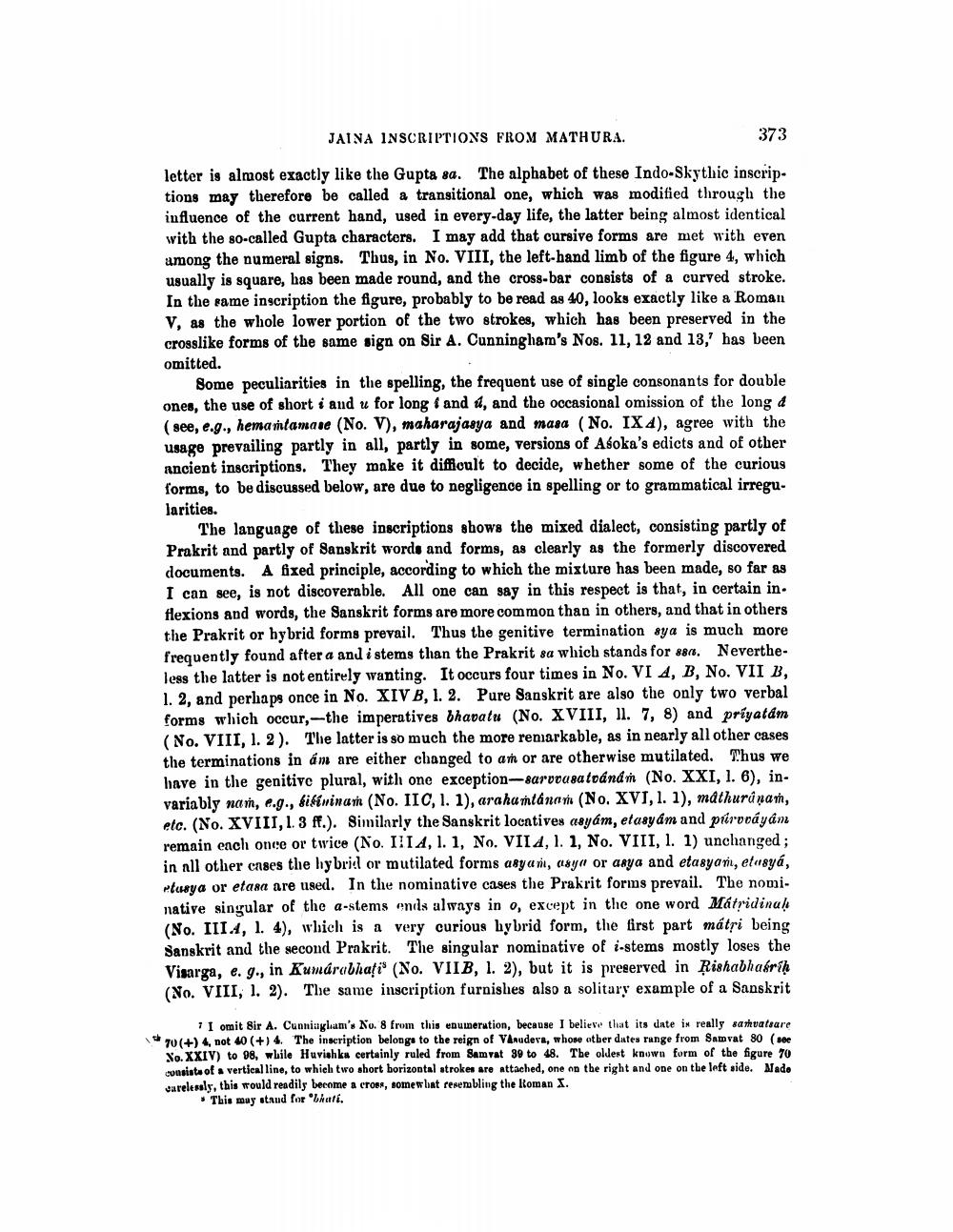________________
JAINA INSCRIPTIONS FROM MATHURA.
373
letter is almost exactly like the Gupta sa. The alphabet of these Indo-Skythic inscrip. tions may therefore be called a transitional one, which was modified through the influence of the current hand, used in every-day life, the latter being almost identical with the so-called Gupta characters. I may add that cursive forms are met with even among the numeral signs. Thus, in No. VIII, the left-hand limb of the figure 4, which usually is square, has been made round, and the cross-bar consists of a curved stroke. In the same inscription the figure, probably to be read as 40, looks exactly like a Roman V, as the whole lower portion of the two strokes, which has been preserved in the crosslike forms of the same sign on Sir A. Cunningham's Nos. 11, 12 and 13,' has been omitted.
Some peculiarities in the spelling, the frequent use of single consonants for double ones, the use of short i and u for long and it, and the occasional omission of the long d ( see, e.g., hemamtamare (No. V), maharajasya and masa (No. IX A), agree with the usage prevailing partly in all, partly in some, versions of Asoka's edicts and of other ancient inscriptions. They make it difficult to decide, whether some of the curious forms, to be discussed below, are due to negligence in spelling or to grammatical irregu. larities.
The language of these inscriptions shows the mixed dialect, consisting partly of Prakrit and partly of Sanskrit words and forms, as clearly as the formerly discovered documents. A fixed principle, according to which the mixture has been made, so far as I can see, is not discoverable. All one can say in this respect is that, in certain in. flexions and words, the Sanskrit forms are more common than in others, and that in others the Prakrit or hybrid forms prevail. Thus the genitive termination sya is much more frequently found after a and i stems than the Prakrit sa which stands for 88. Nevertheless the latter is not entirely wanting. It occurs four times in No. VI A, B, No. VII B, 1. 2, and perhaps once in No. XIV B, 1. 2. Pure Sanskrit are also the only two verbal forms which occur,--the imperatives bhavatu (No. XVIII, 11. 7, 8) and priyatam (No. VIII, 1. 2). The latter is so much the more remarkable, as in nearly all other cases the terminations in an are either changed to an or are otherwise mutilated. Thus we bave in the genitive plural, with one exception-arvoasatoanám (No. XXI, 1. 6), invariably nam, e.g., fifiwinan (No. IIC, 1. 1), arahantánam (No. XVI, 1. 1), mathurûnan. etc. (No. XVIII, 1.3 ff.). Similarly the Sanskrit loontives asyám, elasy ám and prirováy án remain each once or twice (No. III, 1. 1, No. VIIA, 1. 1, No. VIII, 1. 1) unchanged ; in all other cases the hybridl or mutilated forms asyan, asya or anya and etasyari, etasya, musya or etasa are used. In the nominative cases the Prakrit forms prevail. The nominative singular of the a-stems ends always in o, except in the one word Mátridinah (No. IIIA, I. 4), which is a very curious hybrid form, the first part mátri being Sanskrit and the second Prakrit. The singular nominative of i-stems mostly loses the Visarga, e.g., in Kumárabhati* (No. VIIB, I. 2), but it is preserved in ħishabhabrik (No. VIII, 1. 2). The same inscription furnishes also a solitary example of a Sanskrit
11 omit Sir A. Cunningham's No. 8 from this enumeration, because I believe that its date is really sashuattare 70 (+)4, not 40 (+) 4. The inscription belongs to the reign of Varuders, whose other dates range from Samvat 80 (see No. XXIV) to 08, while Huvishka certainly ruled from Samvat 99 to 48. The oldest known form of the figure 70 consists of a vertical line, to which two short borizontal strokes are attached, one on the right and one on the left side. Mado surelenly, this would readily become a cross, somewhat resembling the Roman ..
. This may staud for hati.




